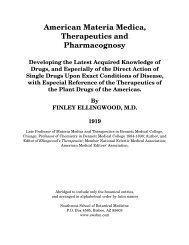SCARLET FEVER. Synonyms.—Scarlatina; Scarlet Rash. Definition ...
SCARLET FEVER. Synonyms.—Scarlatina; Scarlet Rash. Definition ...
SCARLET FEVER. Synonyms.—Scarlatina; Scarlet Rash. Definition ...
Create successful ePaper yourself
Turn your PDF publications into a flip-book with our unique Google optimized e-Paper software.
Gastro-Intestinal Disturbance.—The stomach early feels the force of the<br />
toxin, which is seen in the furred tongue. There is frequent nausea and<br />
sometimes vomiting, especially in the advanced stages and after a<br />
paroxysm of coughing. Often the tongue, which is narrow, elongated,<br />
reddened at tip and edges, speaks of an irritable stomach, which is<br />
attended by some pain and tenderness in the epigastric region. Small<br />
ulcers in the mouth are frequent, and are annoying to the patient.<br />
Diarrhea.—While diarrhea may occur early in the disease, it is usually<br />
found in the advanced stages, and is one of the serious complications,<br />
adding greatly to the prostration. These unfortunates often have<br />
painful hemorrhoids or fistulas, which later increase the suffering and<br />
still further lower the vitality of the already reduced system.<br />
Nervous System.— “Hope springs eternal in the human breast,” is<br />
certainly true in this class of patients, and they are ever planning for<br />
the time when they shall regain their health, are easily encouraged<br />
with any favorable symptom, while changes for the worse are regarded<br />
as only temporary. Derangements of the nervous system are quite rare.<br />
Complications.—An acute pneumonia is not an infrequent complication,<br />
while a diseased pleura is nearly always found at some stage of the<br />
disease. One of the most distressing complications is the involvement of<br />
the larynx. The husky voice or persistent attempt to clear the throat<br />
announces its presence. As the disease extends, aphonia becomes more<br />
complete, and the patient swallows with difficulty. Finally when<br />
ulceration extends to the epiglottis and walls of the pharynx,<br />
swallowing is no longer possible, food and fluids return through the<br />
nose, and the patient literally starves to death.<br />
Physical Signs.—Inspection.—The eye reveals, to the skilled<br />
physician, definite and important conditions, characteristics that either<br />
tell of phthisis or of one susceptible, to the disease.<br />
The chest is long, narrow, and flat, with increased width of the<br />
intercostal spaces. The scapula stand out prominently like wrings, while<br />
the epigastric angle is usually acute. Where cavity formation has taken<br />
place, there is flatness, the most frequent place being over the left apex.<br />
We are to remember, however, that part of this is due to atrophy of the<br />
chest muscles. This chest is known as the “paralytic” or “phthisical<br />
chest.” The respiration is diminished in all stages, but particularly over<br />
the apex.<br />
The Eclectic Practice of Medicine - PART I - Infectious Diseases - Page 201

















